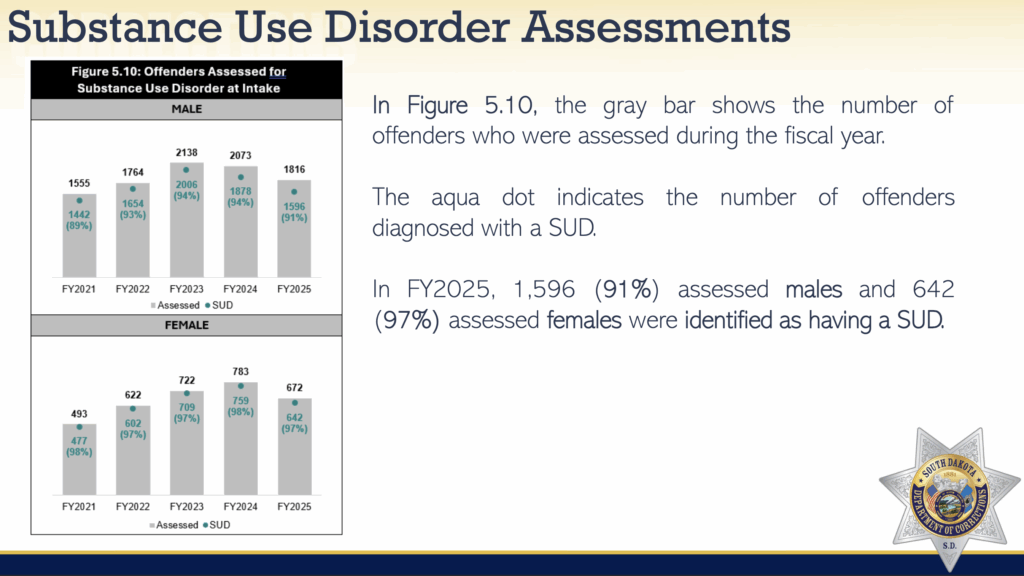The Department of Corrections told the newly convened Correctional Rehabilitation Task Force yesterday that, as of June 30, 1,048 out of the 3,783 convicts it held—28%—were in for drug offenses. But a more telling and challenging statistic for prison rehabilitation lies in this slide on drug problems among inmates:

2,238 inmates—1,596 men, 642 women—are addicted to drugs or alcohol. Over half (59%) of the inmates can’t make reliable, rational choices to better themselves and avoid committing more crimes because they are hooked on booze, meth, or some other addictive substance.
No rehabilitative program will stick if it does not get inmates to kick their addictions.
But even if we can help prisoners get clean, our society will keep feeding the prisons new addicts whose chemical habits will lead them into bad choices and unpleasant interactions with law enforcement. If we really want to decrease the prison population, we have to turn to Judge Tim Bjorkman’s 2017 analysis of the social problems that cause our increasing incarceration rates:
[from DFP, 2017.12.24] Bjorkman’s paper is chock full of statistics about our state’s high incarceration rate (growing 30 times faster than our population over the last 40 years) and the dysfunctional background of most prisoners (two thirds with no high school diploma, 90% suffering from a substance disorder, over half the female prisoners survivors of child abuse). Bjorkman ties these dysfunctions to income inequality (low-income students with high test scores are less likely to finish college than high-income kids with low test scores), poverty, and breakdown of family structure (more pronounced among low-income Americans). These disadvantages sabotage children’s development in multiple ways, turning even their own neurobiology against them:
…A child subjected to frequent and prolonged adversity tends to develop what academicians call toxic stress…. Children in such settings build up higher levels of cortisol, a vital stress hormone. As part of the body’s fight or flight mechanism, the child’s adrenal glands release cortisol in response to fear or stress.
For most people, once the immediate crisis has abated, the body’s cortisol levels return to normal. In a child exposed to continual stress, however, cortisol remains stored in the body, rather than dissipating. Those elevated cortisol levels interfere with one’s learning, memory and ability to concentrate, and can lead to depression, mental illness, [and] a host of other long-term health problems.
Exposure to constant stress in the home can disrupt executive functions and disturb the ability to follow directions and address basic challenges…. Perhaps worst of all, the hormone buildup attacks the last refuge of a child living in a toxic environment: resiliency, the ability to overcome life’s adversities [footnote citations replaced with links; Timothy W. Bjorkman, “A State in Shackles: The Effect of a Dysfunctional Childhood on Crime and Imprisonment,” South Dakota Law Review, Vol. 62, 2017, p. 227].
Solving social ills is likely beyond the scope of the Correctional Rehabilitation Task Force. But if we really want to avoid filling our prisons beyond capacity, we have to reform not the prisons but society. We need to prehabilitate—make every child able to deal with adversity by keeping them and their families from falling into crushing poverty. We need to remedy income inequality and the dissolution of family and community bonds that produce humans who can’t cope. Prisons can’t correct these ills; we need to correct those ills with economic reforms that will reduce the need for a Corrections Department.
Want to fix prison overcrowding? Legalize cannabis.
Recall 2020 presidential candidate, Andrew Yang wanted to implement a universal basic income of $12,000 a year and guaranteed income (GI) demonstration projects are underway in several states including in Colorado and New Mexico where cannabis is legal. Minnesota is still working on a basic income proposal but South Dakota is one Earth hating state where food insecurity is rampant and the infant mortality rate is nearly the worst in the US.
South Dakota is the second most gambling addicted state according to a WalletHub survey conducted in 2024. Nevertheless, Republicans want to raise video lootery limits so those least able to pay will continue to sustain red state failure even though the best place for addicts can buy meth is at bars with video lootery terminals. Yes, the state that calls itself conservative depends on federal Social Security benefits to pay the property taxes that bankroll ecocide and pay the bulk of South Dakota’s bills while video lootery drives poor residents even further into despair.
Governor Mickelson had a choice. He chose gambling over an income tax. He had another choice. Separate gambling from alcohol emporiums. He united them. And that, ladies and gentlemen, accounts for a lot of South Dakota’s problems.
Check on Portugal decriminalizing drugs. Its been an overwhelming success. It won’t happen here but it’s always nice to point out truths to Republicans.
“We need to prehabilitate—make every child able to deal with adversity by keeping them and their families from falling into crushing poverty. We need to remedy income inequality and the dissolution of family and community bonds that produce humans who can’t cope.”
Hi Cory!
Hear! Hear! How do we best do this?
Oak Hills Baptist Church has “adopted” a low-income elementary school for about 5 years now, providing many children with mentors and after school activities. Is that what you have in mind?
Kind regards,
David
I was a cortisol kid.